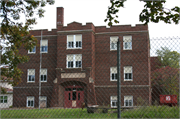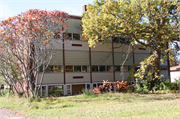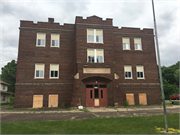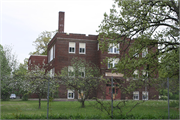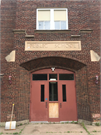| Additional Information: | A 'site file' exists for this property. It contains additional information such as correspondence, newspaper clippings, or historical information. It is a public record and may be viewed in person at the Wisconsin Historical Society, Division of Historic Preservation-Public History.
2017 WisDOT survey - The property is a former public elementary school property, which occupies a full city block, bounded by 11th Street, Main Street, Wilson Avenue, and 12th Street. The school building is oriented to the west, fronting on 11th Street. The former school building is centered on the property and a modern residence is located on the northeast corner of the lot, at 702 12th Street. The landscaping surrounding the school includes flowering trees and plantings; a chain-link fence partially encircles the lot.
The original school building is a 1925 three-story Collegiate Gothic-style building that has been expanded by a three-story T-plan mid-century addition on the east elevation. The 1925 building is a brick structure with a flat roof that is encircled by a crenelated parapet. Centered on the façade is a three story pavilion that houses the main entrance. At the base of the pavilion is an arched opening to the recessed doors. Above the doors is a stone inset nameplate that reads “PUBLIC SCHOOL.” Windows on the school are replacement units, placed in pairs on the entrance pavilion, and singling on the remainder of the façade. Windows on the side elevations of the original building are set in three bays, consisting of a single window in the outer bays and a string of three windows at the center. Each window is a small horizontal slider placed into the original openings; a small panel has been applied above the sash to infill the rest of the much larger opening.
Like the original school, the rear addition is a three-story brick structure with a flat roof. The primary exterior entrance to the addition is on the south elevation of the connecting ell. The elevation appears to have historically been completely glazed, but now has infilled panels of synthetic material. The entrance itself is on the first story, sheltered under a flat canopy. Much of the addition’s remaining fenestration is on the east elevation, which is divided into six bays. The second and third stories of the bays contain upper spandrels of glass block, with a string of three single-light windows below. Below each string of windows is a string of light colored brick. The first story has modern single-light windows of irregular sizes and spacing. This section of the first story is clad in vinyl siding. The north elevation of the building has strings of single light windows placed either singly or in strings of three windows.
2017-2018 Survey Report Recommendation Write-Up:
Executed in the Collegiate Gothic style and featuring a crenelated parapet, the original, two-story plus raised basement block (1925) is clad with red brick and trimmed with stone, while the two-story 1953 addition is finished with glazed brick and wide expanses of windows. Regarding the former, the primary entrance faces 11th Street East and is set within a three-story tower projection. The replacement metal doors are set within a deep arch, above which is a stone panel that reads “PUBLIC SCHOOL.” A single battered buttress frames the doorway which also includes crenellation along the top. Windows along each floor of the primary elevation are arranged in pairs and all openings have been downsized and include replacement slider-type windows. Behind the 1925 block is an addition that consists of a two-story block that connects to the two-story plus raised basement 1953 wing. Both the north and south ends of the building are finished with red brick, while the full first and second floors of the east elevation are comprised of glazed brick spandrels, a narrow line of fenestration and a wider section of glazed square tile. The basement-level fenestration has been replaced and also includes sections of vinyl siding.
Following a petition by the residents of the East School district, the subject East School was built in 1925, replacing an earlier two-room school. At the start of the project, the school’s cost was estimated at $30,000. The architect for East School was St. Paul’s Lambert Bassindale, who also designed the North School (1924; no longer extant but formerly located in North Menomonie--along Pine Street, between Stout and Tainter streets). Actual construction was completed by Pehrson Bros. The school (which ultimately cost $35,000) opened in November 1925 and, as of the first full school year (1926-27), 110 students were enrolled in grades K-6. This school served the district well until circa 1951, by which time additional classrooms were needed for the growing student population, which was recorded at 163 in 1952. Work began on the approximately $150,000 addition in July 1952. Designed by architect William Ingemann of St. Paul, Minnesota, and built by the J.T. Olson Co., Chippewa Falls, Wisconsin, it was completed in 1953 and included the following: two classrooms and a library (first floor); two classrooms and a bathroom (second floor); and a recreation room, kitchen and heating plant (basement). This expansion allowed the school to serve K-7th grade students, whereas it had served only four grades immediately preceding the addition. In 1958, the boiler room and the library were both converted for classroom use. East School continued to serve area students until Oaklawn Elementary School was completed in 1993.
Lambert Bassindale, architect of the original 1925 block, was born in 1875 in Racine, Wisconsin. He received his education from the Chicago Art Institute and worked in Chicago for a number of years, reportedly with Jarvis Hunt and Charles Frost. Bassindale, who had worked as an architect for the Northern Pacific Road, went to St. Paul, Minnesota, circa 1918, as an associate architect with Frost, for the construction of the St. Paul Union Depot and the Great Northern Station in Minneapolis. Bassindale’s work included banks, office buildings, hotels, railroad-related buildings and schools; however, he is likely most well-known for the Federal Building in St. Paul, which was designed along with Holabird & Root of Chicago. Aside from Menomonie’s North School (no longer extant), the only other known design of Bassindale in Wisconsin is the Journal-Times Building (1922; 1939) at 212 4th Street in Racine, Wisconsin. |
|---|
| Bibliographic References: | Citations for 2017-2018 Survey Report Recommendation Write-up below: “Petition Board to Change Plan of East School,” Dunn County News, 26 February 1925, 1/5, 2/3; “Legerdemain New Attempt of School Board,” Eau Claire Leader, 5 March 1925, 2/4; “East School’s Plan is Ready,” Eau Claire Leader, 3 April 1925, 3/5; “Bidding Heavy on East School Building Work,” Eau Claire Leader, 15 April 1925, 2/5; “Open East School Monday Morning,” Eau Claire Leader, 26 November 1925, 3/4; “New East School in Full Swing,” Eau Claire Leader, 2 December 1925, 2/2; “Invite Public to Inspect New East School Building,” Dunn County News, 3 December 1925, 1/3, 2/1-2; “Start Move for Four-Room Addition to East School,” Dunn County News, 5 December 1951, 1/4-5; “Official Proceedings of the Board of Education,” (cites architect), Dunn County News, 23 January 1952, 6/1-2; “Need for East School Addition Explained in Statistical Report,” Dunn County News, 12 March 1952, 1/6-8; “Proposed East School Addition,” photo and caption, Dunn County News, 19 March 1952, III/1-3; “City Voters Approve Funds for East School Addition,” Dunn County News, 2 April 1952, 1/7-8; “Work on East School Starts at Once,” Dunn County News, 23 July 1952, III-1/1, 6/3; “Use of Menomonie School Addition Set for January,” Eau Claire Leader, 19 August 1952, 2/1-2; “East School Addition,” Dunn County News, 19 August 1953, III-5/4; “To Remodel East School Boiler Room,” Dunn County News, 25 June 1958, II-6/5; “Menomonie School Population Growth to Require New Buildings,” Eau Claire Leader, 31 March 1968, 12/3-6.
“New St. Paul Hotel Work of Racineite,” The Racine Journal-News, 17 June 1927, 4/4; Donald Huth, “Public Invited to Opening of New Plant,” The Journal-Times (Racine, WI), 24 February 1939, 45/top; “Long Illness Ends in Death at Home Here,” The Alexander Times-Tribune (Alexandria, IN), 16 May 1945, 1/4; Withey and Withey, Biographical Dictionary of American Architects, 41. Based on information included on the website of the Northwest Architectural Archives at the University of Minnesota, the 1925 plans for East School are on file there, Lambert Bassindale Papers, information available online at https://archives.lib.umn.edu/repositories/8/resources/2288, Accessed August 2018. |
|---|

